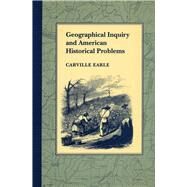Geographical Inquiry and American Historical Problems
, by Earle, Carville- ISBN: 9780804715751 | 0804715750
- Cover: Hardcover
- Copyright: 4/1/1992
The twelve essays in this volume reexamine a handful of perennial problems in American history from a geographical point of view. From this perspective there emerges a series of reinterpretations of the central processes that defined the American experience, whether of colonization, of regional development and sectionalism, of slavery and freedom, of urbanization and industrialization, or of working-class history. The essays encompass the first three centuries of American history, beginning with the nightmarish world of disease and death that was early Virginia and ending with the melancholy demise of socialism early in this century.
Geography's mission is to comprehend changes on the earth's surface, and toward that end, geographers ponder the interactive effects of nature and culture within specific locations and times. This entails connecting human actions (historical events) with their immediate environs (ecological inquiry) and specific coordinates of place and region (locational inquiry).
Most of the essays in this volume employ the variant of ecological inquiry the author calls the staple approach, focusing on primary production (agriculture, forestry, fishing) and its societal ramifications.
Locational inquiry queries the spatial distribution of historical events: Why was mortality in early Virginia highest in a small zone along the James River? Why did cities flourish in early Pennsylvania, Massachusetts, and Carolina and not elsewhere along the Atlantic seaboard? Why was Boston the vanguard of the American Revolution?
The book's first four essays, on the colonial period, reinterpret American colonization and regional development. The second four essays unravel the causes of sectional differences in the north and south during the early national and antebellum periods. The next three essays shift to the American urban scene, tracing the influence of agrarian society on the geography of labor and labor politics between the Civil War and World War I. The book then concludes with a long and ambitious overview of the periodic structure of the entire American past. This final essay offers at once a synthesis of the various historiographic case studies and a compelling interpretation of the rhythms of American macrohistory and their geographical component. The book is illustrated with 12 halftones.
Geography's mission is to comprehend changes on the earth's surface, and toward that end, geographers ponder the interactive effects of nature and culture within specific locations and times. This entails connecting human actions (historical events) with their immediate environs (ecological inquiry) and specific coordinates of place and region (locational inquiry).
Most of the essays in this volume employ the variant of ecological inquiry the author calls the staple approach, focusing on primary production (agriculture, forestry, fishing) and its societal ramifications.
Locational inquiry queries the spatial distribution of historical events: Why was mortality in early Virginia highest in a small zone along the James River? Why did cities flourish in early Pennsylvania, Massachusetts, and Carolina and not elsewhere along the Atlantic seaboard? Why was Boston the vanguard of the American Revolution?
The book's first four essays, on the colonial period, reinterpret American colonization and regional development. The second four essays unravel the causes of sectional differences in the north and south during the early national and antebellum periods. The next three essays shift to the American urban scene, tracing the influence of agrarian society on the geography of labor and labor politics between the Civil War and World War I. The book then concludes with a long and ambitious overview of the periodic structure of the entire American past. This final essay offers at once a synthesis of the various historiographic case studies and a compelling interpretation of the rhythms of American macrohistory and their geographical component. The book is illustrated with 12 halftones.






